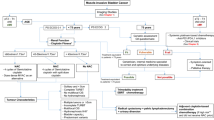Abstract
Objectives
To determine the current trends in the follow-up of patients with muscle-invasive bladder cancer following radiotherapy, among consultants in the United Kingdom and the republic of Ireland in terms of cystoscopic survey and imaging of the upper tracts.
Methods
A national postal survey was carried out in 2006 including 602 urologists registered with the British Association of Urological Surgeons (BAUS).
Results
About 40% of the consultants participated in the survey. Seventy-seven per cent performed cystoscopy 3 months post-radiotherapy and 78% used rigid cystoscopy. The majority (91%) did not take routine random biopsies at the time of the first cystoscopy if it looked normal. Seventy-eight per cent of the participants requested upper-tract imaging in the presence of cystoscopic abnormalities, and long-term follow-up was recommended by 75%.
Conclusions
There is a wide-range of practice regarding the first check cystoscopy following radiotherapy for muscle-invasive bladder cancer and it could prove the foundation for more randomised trials to determine the evidence-based practice.
Similar content being viewed by others
References
Stenzl A, Cowan NC, De Santis M et al (2009) The updated EAU guidelines on muscle-invasive and metastatic bladder cancer. Eur Urol 55(4):815–825
Colli JL, Kolettis PN (2009) Bladder cancer incidence and mortality rates compared to ecologic factors among states in America. Int Urol Nephrol [Epub ahead of print]
Rosario DJ, Becker M, Anderson JB (2000) The changing pattern of mortality and morbidity from radical cystectomy. BJU Int 85(4):427–430
Hautmann RE, de Petriconi R, Gottfried HW et al (1999) The ileal neobladder: complications and functional results in 363 patients after 11 years of followup. J Urol 161(2):422–427
Hellsten S, Rintala E, Wahlqvist R, Malmström PU (1998) Nordic prospective trials of radical cystectomy and neoadjuvant chemotherapy. The Nordic cooperative bladder cancer study group. Eur Urol 33(4):35–38
Johnson DE, Lamy SM (1977) Complications of a single stage radical cystectomy and ileal conduit diversion: review of 214 cases. J Urol 117(2):171–173
Tran E, Souhami L, Tanguay S, Rajan R (2009) Bladder conservation treatment in the elderly population: results and prognostic factors of muscle-invasive bladder cancer. Am J Clin Oncol 32(4):333–337
Efstathiou JA, Bae K, Shipley WU et al (2009) Late pelvic toxicity after bladder-sparing therapy in patients with invasive bladder cancer: RTOG 89-03, 95-06, 97-06, 99-06. J Clin Oncol 27(25):4055–4061
Parker CC, Huddart RA (1996) Management of invasive bladder cancer. Br J Hosp Med 56(5):213–218
Neilson D, Colins G, Hertley S, Livsey J (2007–2008) North west urology audit. http://www.burypct.nhs.uk/fileadmin/user_upload/health_promotion/test_page_2/Paul/2008_Urology_report.pdf
Ott OJ, Rödel C, Weiss C, Wittlinger M, St Krause F, Dunst J, Fietkau R, Sauer R (2009) Radiochemotherapy for bladder cancer. Clin Oncol (R Coll Radiol) 21(7):557–565
Weiss C, Wittlinger M, Engehausen DG, Krause FS, Ott OJ, Dunst J, Sauer R, Rödel C (2008) Management of superficial recurrences in an irradiated bladder after combined-modality organ-preserving therapy. Int J Radiat Oncol Biol Phys 70(5):1502–1506
Hussain SA, Stocken DD, Peake DR et al (2004) Long-term results of a phase II study of synchronous chemoradiotherapy in advanced muscle invasive bladder cancer. Br J Cancer 90(11):2106–2111
Pavone-Macaluso M, Lamartina M, Pavone C, Vella M (1992) The flexible cystoscope. Int Urol Nephrol 24(3):239–242
Yoshimura R, Wada S, Kishimoto T (1999) Why the flexible cystoscope has not yet been widely introduced? A questionnaire to Japanese urologists. Int J Urol 6(11):549–559
Gidlow AB, Laniado ME, Ellis BW (2000) The nurse cystoscopist: a feasible option? BJU Int 85(6):651–654
Fagerberg M, Nostell PO (2005) Follow up of urinary bladder cancer–a task for the urology nurse? Lakartidningen 102(30–31):2149–2150
Taylor JM, Pearce I, O’Flynn KJ (2002) Nurse-led cystoscopy: the next step. BJU Int 90(1):45–46
Swinn MJ, Walker MM, Harbin LJ et al (2004) Biopsy of the red patch at cystoscopy: is it worthwhile? Eur Urol 45(4):471–474
Bekker M, Beck J, Putter H et al (2009) The place of female sexual dysfunction in the urological practice: results of a Dutch survey. J Sex Med 6(11):2979–2987
Oosterlinck W, Lobel B, Jakse G, Malmström PU, Stöckle M, Sternberg C (2002) European association of urology (EAU) working group on oncological urology. Guidelines on bladder cancer. Eur Urol 41(2):105–112
Author information
Authors and Affiliations
Corresponding author
Appendix: Post-radiotherapy follow-up for bladder cancer muscle-invasive bladder cancer questionnaire
Appendix: Post-radiotherapy follow-up for bladder cancer muscle-invasive bladder cancer questionnaire
-
1.
The timing of the first post-radiotherapy check cystoscopy?
□ 3 months, □ 4 months, □ 6 months, □ Other (please state……………………..)
-
2.
The type of the first post-radiotherapy check cystoscopy?
□ Rigid cystoscopy, □ flexible cystoscopy
-
3.
The person performing the first post-radiotherapy check cystoscopy?
□ Consultant
□ Middle grades
□ SHOs
□ Urology nurse practitioners
□ Others (please state……………………….)
-
4.
Bladder biopsies at the time of first post-radiotherapy cystoscopy?
Normal cystoscopy: □ Yes □ No
Abnormal cystoscopy: □ Resection biopsies □ Cold-cup biopsies
-
5.
Upper-tract imaging
□ Routine,
□ In the presence of abnormal cystoscopy
□ In the presence of abnormal Examination under anaesthesia
□ Others (please state…………)
-
6.
Long-term follow-up plan
□ Lifelong follow-up
□ Stop after 10 years with no recurrence
□ Others (please state……………………)
Rights and permissions
About this article
Cite this article
Mohammed, A., Hameed, A., Shergill, I. et al. The practice of the first check cystoscopy following radiotherapy for the treatment of muscle-invasive (T3N0M0) bladder cancer: a UK national survey. Int Urol Nephrol 43, 377–381 (2011). https://doi.org/10.1007/s11255-010-9789-5
Received:
Accepted:
Published:
Issue Date:
DOI: https://doi.org/10.1007/s11255-010-9789-5




